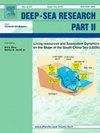The behavior of particulate matter in the Persian Gulf: biogeochemical proxies for source identification
IF 3
3区 地球科学
Q2 OCEANOGRAPHY
Deep-sea Research Part Ii-topical Studies in Oceanography
Pub Date : 2025-07-06
DOI:10.1016/j.dsr2.2025.105505
引用次数: 0
Abstract
The present research study is intended to assess the probable sources of suspended particulate matter (SPM) in the Persian Gulf. SPM was collected at three to four depth resolutions: surface, 10 and/or 25 m, and 2–3 m above the seabed over three research cruises: PGE1901 (May 2019), PGE1902 (November 2019), and PGE2101 (March 2021). The SPM concentration exhibits several maxima along the northern coastline and is higher in winter than spring and autumn. SPM consisted of calcium carbonate (CaCO3), opaline silica (SiO2), organic matter, detrital matter from the upper continental crust (UCC), and contaminants derived from industrial activities (e.g., leaking or combustion of fossil fuels). Particulate organic matter (POM) is the major fraction in offshore samples, accounting for up to 84 % of the particulate mass, while the contribution of MnO2 is lower than 0.1 % during the three seasons. The particulate CaCO3 content varied more than other major components, being lowest in the northern Strait of Hormuz and up to 40 % in the region near the southern carbonate shelf. Strong coupling among the biochemical parameters Chl-a, bSi, TPP, and TPN was observed during the winter, likely reflecting higher autotrophic contributions to the particulate organic matter (POM). The decrease in TPN from autumn to winter, along with increases in Chl-a and TPP, resulted in three- and two-fold drops in N:Chl-a and N:P ratios, respectively. The concentrations of metal elements decrease in the general order of Ca > Fe > Al > Zn > Ti > Mn > Cr > Cu > Ni > Pb > V > Mo > Cd. Most of the elements exhibit enrichment levels ranging from 50 to 5000 times higher than the values found in the upper continental crust, with notable exceptions for titanium (Ti) and manganese (Mn). Except for cadmium, with a Me/P ratio close to the reported intracellular values, phytoplankton's contribution to the particulate pool of other bioactive trace elements barely exceeds 15 %. The predominant fraction of particulate Pb, Zn, Cu, and Ni is beyond the dust and phytoplankton contribution, possibly from the long-term accumulation of these elements, with some signs of local anthropogenic input.
波斯湾颗粒物质的行为:来源识别的生物地球化学代理
本研究旨在评估波斯湾悬浮微粒物质(SPM)的可能来源。SPM在三到四种深度分辨率下收集:表面,10和/或25米,海床以上2-3米,三个研究巡航:PGE1901(2019年5月),PGE1902(2019年11月)和PGE2101(2021年3月)。SPM浓度在北部海岸线有几个极大值,冬季高于春季和秋季。SPM由碳酸钙(CaCO3)、乳白色二氧化硅(SiO2)、有机质、上大陆地壳碎屑(UCC)和工业活动(如化石燃料泄漏或燃烧)产生的污染物组成。颗粒有机质(POM)是近海样品中主要组分,占颗粒质量的84%,而MnO2的贡献在三个季节中均低于0.1%。颗粒CaCO3含量变化较大,在霍尔木兹海峡北部最低,在南部靠近碳酸盐岩陆架的地区高达40%。在冬季,生化参数Chl-a、bSi、TPP和TPN之间存在强耦合,可能反映了颗粒物有机质(POM)自养贡献较高。秋冬季节TPN的减少,以及Chl-a和TPP的增加,导致N:Chl-a和N:P分别下降3倍和2倍。金属元素的浓度按Ca >的一般顺序递减;菲比;阿尔比;锌比;Ti祝辞Mn祝辞Cr祝辞铜比;倪祝辞Pb祝辞V比;莫在除钛(Ti)和锰(Mn)外,大多数元素的富集水平比大陆上地壳的富集水平高50至5000倍。除镉外,浮游植物对其他生物活性微量元素微粒池的贡献仅略高于15%,其Me/P比值接近于报道的胞内值。Pb、Zn、Cu和Ni颗粒的主要成分超出了尘埃和浮游植物的贡献,可能来自这些元素的长期积累,并有局部人为输入的迹象。
本文章由计算机程序翻译,如有差异,请以英文原文为准。
求助全文
约1分钟内获得全文
求助全文
来源期刊
CiteScore
6.40
自引率
16.70%
发文量
115
审稿时长
3 months
期刊介绍:
Deep-Sea Research Part II: Topical Studies in Oceanography publishes topical issues from the many international and interdisciplinary projects which are undertaken in oceanography. Besides these special issues from projects, the journal publishes collections of papers presented at conferences. The special issues regularly have electronic annexes of non-text material (numerical data, images, images, video, etc.) which are published with the special issues in ScienceDirect. Deep-Sea Research Part II was split off as a separate journal devoted to topical issues in 1993. Its companion journal Deep-Sea Research Part I: Oceanographic Research Papers, publishes the regular research papers in this area.

 求助内容:
求助内容: 应助结果提醒方式:
应助结果提醒方式:


